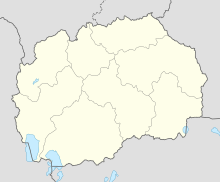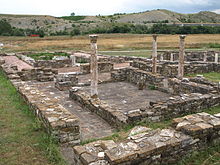Stobi
Coordinates: 41 ° 33 ′ 6.3 " N , 21 ° 58 ′ 29.9" E
Stobi ( ancient Greek Στόβοι , Cyrillic Стоби ) was the capital of the ancient Paionia landscape , was later conquered by the Macedonians and came together with Macedonia in the 2nd century BC. Under the rule of the Romans . Stobi lay at the mouth of the Erigon River in the Vardar on the main road that connected the middle Danube with the Aegean coast . The ruins of Stobi are the most significant ancient remains on the territory of the Republic of Macedonia today .
The site is located immediately north of the Macedonian A1 motorway , also known as Autoput Bratstvo i jedinstvo , south of the village of Gradsko . The excavation site and the restored buildings form an open-air museum.
The pre-Roman times
Stobi was founded by the Paionians . The place of settlement had been settled several times since the Neolithic , because it was in a very favorable area for agriculture and on a north-south connection that was important for Balkan trade . However, the flat terrain offered few opportunities to fortify the site. Originally the populated area was barely 2.5 hectares . The fact that the pioneers made Stobi their capital in the 5th century - previously it was Bylazora further north - contributed to the prosperity of the city.
Philip II conquered Paionia around 350 BC. And incorporated the country into his empire. However, there was a limited dependency, because in Stobi there were still Paionic kings who ruled as Philip's governor. In the 4th and 3rd centuries, the population of Stobis was largely Hellenized .
Roman time
After the Roman victory over Macedonia in 167 BC. Was 148 BC. The Roman province Macedonia was formed, to which Stobi belonged. The city played no role in the administrative organization of the Romans. In the city, however, several Roman roads crossed , branches of the Via Egnatia and the Via Militaris . The city developed well and the population grew rapidly, as can be seen from the multiple expansion of the built-up area. In 69 AD the city received the status of a municipality . From this time some coins of the municipium Stobensium are known.
After the administrative reform of Emperor Diocletian , Stobi became the capital of the Macedonia salutaris province , which essentially comprised the old Paionien. In 325 Budius took part in the Council of Nicaea as Bishop of Stobi . Emperor Theodosius I stayed in Stobi for a few months in 388. The city began to decline in the second half of the 5th century. In 479 it was captured and plundered by the Ostrogoths under Theodoric . In 518 Stobi was devastated by a strong earthquake; after the invasions of the Avars and Slavs 30 years later, Stobi was finally abandoned.
Excavations
During the First World War, Austrian officers carried out a superficial examination of the ruins. From 1924 to 1936, the Belgrade National Museum carried out several excavation campaigns. The archaeologists discovered houses, two basilicas and the theater built in the 3rd century. Overbuilt Hellenistic graves were found during the Second World War . In 1955, researchers discovered Slavic tombs from the 8th to 12th centuries in the northern basilica, bronze statues from Classical and Hellenistic times, as well as Neolithic ceramics and building structures that could be identified as synagogues . Between 1970 and 1980 a team of Yugoslav-American archaeologists again carried out major excavations. Numerous other buildings, water pipes and mosaics were discovered; in addition, the necropolis west of the city was systematically examined. From 1981 to 1988 a new team finally excavated the late Roman bishopric and the Christian basilica.
literature
- Virginia R. Anderson-Stojanović: Stobi. The Hellenistic and Roman pottery. Princeton 1992, ISBN 0-691-03605-5 .
- Caroline Jane Hemans: Late antique wall painting from Stobi, Yugoslavia. Dissertation Bloomington 1987.
- Pero Josifovski: Римската монетарница во Стоби [= A Roman mint in Stobi]. Skopje 2001, ISBN 9989-9501-2-1 .
- Ruth Ellen Kolarik: The floor mosaics of Stobi and their Balcan context. Dissertation Cambridge, Mass. 1981.
- Djordje Mano-Zissi, James Wiseman (ed.): Studies in the antiquities of Stobi (= Proucavanja starina u Stobima). 3 vols. Beograd 1.1973; 2.1975; 3.1981.
- Ivan Mikulcik: Стоби. Антички град (= Stobi. An Ancient City). Skopje 2003, ISBN 9989-144-09-5 .
- David Noy; Alexander Panayotov; Hanswulf Bloedhorn (Ed.): Inscriptiones Judaicae Orientis I: Eastern Europe (Texts and Studies in Ancient Judaism 101). Mohr Siebeck, Tübingen 2004, ISBN 3-16-148189-5 , pp. 56-75
- Eleonora Petrova: Стоби. Водич [= stobi. Guide]. Skopje 2003, ISBN 9989-917-18-3 .
- Balduin Saria : The Stobi Theater. In: Archäologischer Anzeiger , 1938.
- Carolyn Sue Snively: The early Christian basilicas of Stobi. A study of form, function and location. Diss. Austin TX 1979.
- James Wiseman: Stobi. A guide to the excavations. Beograd 1973.
- James Wiseman: Stobi Yugoslavia . In: Richard Stillwell et al. a. (Ed.): The Princeton Encyclopedia of Classical Sites. Princeton University Press, Princeton NJ 1976, ISBN 0-691-03542-3 .
- Slavica Babamova: Inscriptiones Stoborum (Studies in the Antiquities of Stobi. Monograph Series, Book I). Stobi 2012, ISBN 978-608-4688-02-0
Web links
- A detailed article on Stobi. (English)
- Stobi: map, plans and illustrations of finds (English)




